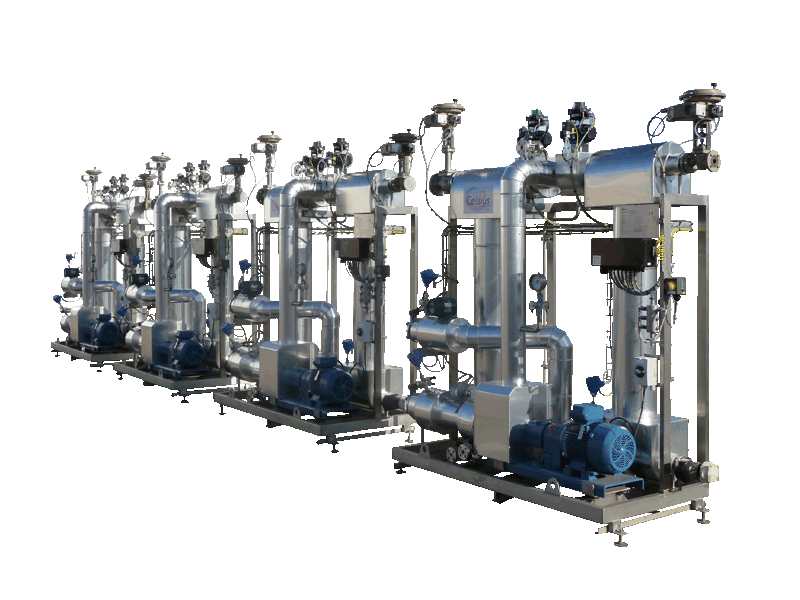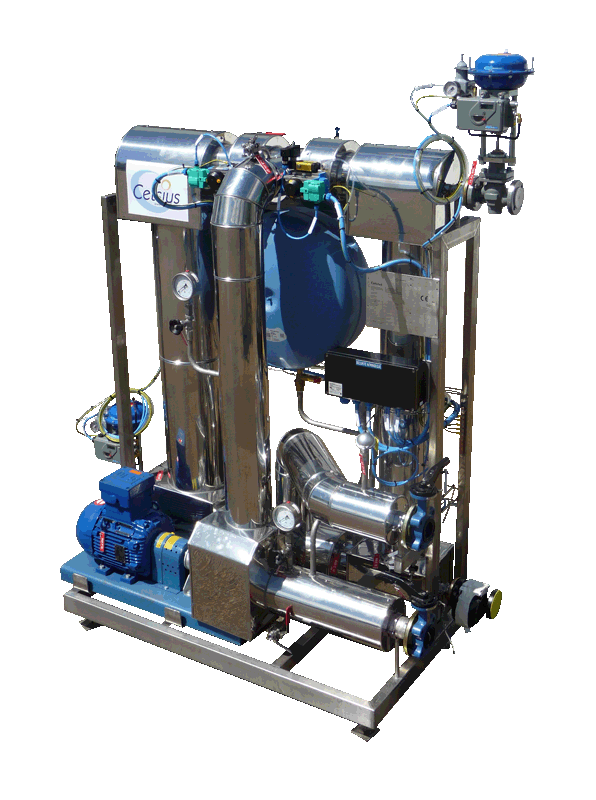
Assembly in skids
The construction in our workshop of equipment in the form of ready-to-install skids reduces costs and installation times on site

FUNCTIONAL ASSEMBLIES
CELSIUS builds individual production equipment for the process industries.
- These “special machines” meet a functional need to implement a process developed by CELSIUS or a process developed by the user
- They require all or part of CELSIUS ‘skills in thermal engineering, process engineering, sheet metal works, piping, assembly, automation, etc…
- The skids are studied in a 3D virtual model with the aim of minimizing the dimensions and favorise access to equipment for operation and maintenance. Most often the assemblies remain open with a direct view of the components.
- The skids are delivered fully piped, assembled, cabled and insulated, ready to be connected so that the operator minimizes installation times and costs on site.

- The skids are packed in a type 3b crate or full 4c crate to be handled up to the production site.
- CELSIUS assists the users during the start-up of production unit and trains operating and maintenance personnel.
The design and construction of CELSIUS equipment is most often subject to two European Directives:
- The directive on functional assemblies intended for installation in explosive atmospheres: ATEX 2014/34/EU
- The directive on pressure assemblies: DESP 2014/68/EU
ATEX ZONE ASSEMBLIES
The 2014/34/EU ATEX European Directive is often considered as a mandatory rule for electricians, which is a mistake:
THE ATEX RULE IS IN NO WAY AN ELECTRIC RULE.
Actually, the word “electricity” is only cited once in the whole text Directive and it is about the hazards of static electricity. The ATEX Directive concerns manufacturers, users and not only electricians.

Most devices that we build are installed in ATEX Zone.
They are shaped and built according the ATEX European Directive to avoid any inflammation or explosion hazard as a result of the combination of 3 different factors:
- The presence of a combustible material : reactors, tanks, heat exchangers often contain flammable solvents and flammable volatile components.
- The presence of a combustive material : reactors and tanks are usually built with trapdoors that, once opened, may let oxygen enter the machine or let volatile organic components escape from it.
- An ignition source : a flame, a flash or a very high wall temperature compared to the auto-ignition temperature of the volatile solvent in presence.
Our products are made to avoid any ignition source whereas they work in atmospheres where combustible and combustive materials are often mixed.
Our products are considered as functional assemblies according to the ATEX 2014/34/EU directive.

The Celsius company has the legal rights to manufacture energy skids as category 2 to be used in ATEX zone 2 or 3 and the labelling of our products is made according to conditions of use:
For Energy Control Units: Certificat ATEX 1
For NECTACEL extraction units: Certificat ATEX 2
The labelling of our equipment defines the using conditions:
| 2 | Our products are labelled Category 2 and can be erected in ATEX zones 1 and 2 |
| G | Our products can be used in explosive gaseous atmosphere |
| IIB ou IIC | Nature of the combustible material |
| T3 ou T4 | Temperature range |
Through the manufacture of skids or full production facilities, Celsius puts together various systems with different working modes while ensuring the simultaneous use of all these systems in the specified working conditions will not trigger additional and unplanned risks for users.
The user is responsible for the risk evaluation and danger is codified according to following rules:
Zone classification:
G Risk zones are classified according to danger frequency:
| Zone 0 | An explosive and gaseous atmosphere is permanently present or at least present for an extended period. The only electrical products present in zone 0 are classified category 1. |
| Zone 1 | An explosive and gaseous atmosphere may be temporarily present in normal working conditions. For instance, it is the environment of products built with a trapdoor opened during a normal working operation. The only electrical products present in zone 1 are classified category 1 or 2. |
| Zone 2 | An explosive and gaseous atmosphere might be present in some rare cases and/or for a short duration. For instance, it is the not so close environment of products, those being confined in a controlled atmosphere cell. This cell may occasionally let some volatile solvent out. The only electrical products present in zone 2 are classified category 1, 2 or 3. |
Other risk zones (D) are defined for dusty atmospheres: zone 20, 21 and 22 according to the same frequency rules as described above.
Nature of the combustible:
The explosion group is defined according to the danger rate of the gas or present volatile solvent:
| Groupe I : | For firedamp conditions mines and their equipments. Referential gas: methane. |
| Groupe II : | For other explosive atmospheres divided in : |
| Groupe IIA : | Referential gas : propane. |
| Groupe IIB : | Referential gas : ethylene. |
| Groupe IIC : | Referential gas : hydrogen. |
The nature of combustible materials usually present in chemical synthesis areas or extraction-by-solvent areas differs a lot. The explosion group classified by the user is the Group IIB, which corresponds to all present gas in the fine chemistry industry, except for hydrogen.
The working areas using hydrogen are classified Group IIC.
Temperature range classification:
The temperature range classification is defined according to solvents’ vapours flaming in the area:
- Class T1 : above 450°C
- Class T2 : 300 to 450°C
- Class T3 : 200 to 300 °C
- Class T4 : 135 to 200 °C
- Class T5 : 100 to 135 °C
- Class T6 : 85 to 100 °C
The temperature range of a full ensemble is not only defined according to its electrical components.
An energy skid that is fuelled with 6 bar steam and whom wall temperature reaches 165°C must be labelled T3 temperature range even if its electrical components are of T4 or T6 range.
The instruction manual specifies that this ensemble must be installed in a T3 or safer temperature range area.
The user must not use solvents that vapours may catch fire if in contact with a wall that temperature is lower than 200°C.

Through the manufacture of skids or full production facilities, Celsius puts together various systems with different working modes while ensuring the simultaneous use of all these systems in the specified working conditions will not trigger additional and unplanned risks for users.
Usually, driving motors put up in fine chemistry factories are classified in the T4 temperature range, which means the motor’s wall temperature does not raise past 135°C in any given circumstance, and neither does the temperature of any other system linked to gas.
For T4 range temperature ATEX zone factory whom equipments have been classified the right way, the owner can safely use solvents that flaming temperature is higher than 135°C.
The ranging of T4 electrical motors and the ranging of T6 instruments are factors that have often driven users to classify the whole ATEX Zone of the factory as T4 range temperature.
However, the classification of a factory as T4 forbids the user to work with wall temperatures above 135°C, and even to fuel the factory with 6 bar steam that pipes reach 165°C!
Thus, even is the pump’s motor is ranged as T4, the pump using a 165°C fluid must be classified as T3. Same goes for the reactor’s agitator whom maximum working condition temperature is 165°C.
PRESSURE ASSEMBLIES
When it comes to the building of skids or full operational production units, CELSIUS puts together numerous systems and ensures that the simultaneous use of those materials in the planned working conditions will not create any additional hazards not foreseen by manufacturers.

About pressured full functional ensembles such as those following the PED 2014/68/EU European Directive, CELSIUS provides a CE conformity declaration, certifying the conformity of the installation regarding the PED 2014/68/EU directive but also to any other applying directive, including the ATEX directive. In that case (Cat. I, II, III and IV), the ensemble is marked with a CE plate.

The pressured ensemble is classified according to the highest category of each of its components, except for the relief valve.
Also, the full ensemble is delivered with a notice clarifying things such as working conditions, possible hazards in terms of pressure, temperature, electricity, chemistry, and precautions needed to be reminded by the user.